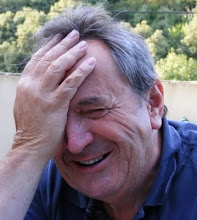Wednesday, September 22, 2010
Painting's different functions in the 18th and 19th Centuries
And then there's landscape; views; the picturesque. Here is one of Canaletto's views of the Thames, painted in 1747 and showing the Lord Mayor's Day Regatta. It speaks of London's importance and grandeur. It exaggerates the width of the Thames and the scale of St Pauls, but remains an astounding panorama of perhaps the most important city in the world at this time. It makes you want to be there, as does this famous painting by John Constable from 1826:
"The Cornfield" is in the long tradition of the English pastoral. We know that it subtly improved on the actual view at the time, but this doesn't matter. It's an ideal English rural view, and actually affects the way we see the countryside. It conditions us to look for the picturesque in our own countryside. It doesn't matter that we know that the lives of those working in the picture were far from idyllic; that they died young from preventable diseases; that they lived in poverty in an unequal society. It captures a moment on a hot summer's day when any of us would be happy to be in the shade and to take a drink from the same stream as the boy in the red waistcoat. It's a landscape which we can navigate in our imagination, through the gateway into the cornfield, and on to the church in the distance.
And then, from four years later there's this:
Samuel Palmer's "Magic Apple Tree" is further removed from reality, drawing on a different tradition which takes in William Blake and the Christian symbolism of the New Jerusalem. You couldn't navigate anywhere from the information in this canvas. This is a mystical picture of a strange and idealised landscape. It speaks of the spirit of place rather than topography, and as such is one of the most famous landscape pictures of the 19th Century, despite having languished in the office of the Director of the Fitzwilliam Museum in Cambridge for a number of years, kept there presumably for his private delectation. This is far removed from Thomas Gainsborough's famous double portrait and landscape of Mr and Mrs Andrews:
This has been called the ultimate 18th Century Capitalist portrait. Painted after the Andrews' wedding in 1750, it shows the happy couple in front of the landscape which they own. I detect a slightly smug air about them. Someone once said (tell me who, please?) that Mr Andrews is saying "This is my dog, this is my gun, this is my land, this is my Wife" - with the emphasis on the possessive pronoun. But there is another view which takes into account Gainsborough's recorded dislike of the "Landed Gentry" - he has painted them as being at odds with the idyllic landscape, him with his gun, she with her inappropriate dress. It's worth recording that he painted this a year after the wedding, when Mr Andrews was 23 and his Wife 17.
And now another strand which grows in importance as we enter the 19th century: animal portraiture.
This is "Whistlejacket", painted for his owner, the Marquess of Rockingham in the early 1760s, when the horse was about 12 years old. By definition racehorses have a short useful life, and rather than rely on memories of Whistlejacket's great victory over a four mile course at York in 1759 (which netted him 2,000 guineas), the noble owner commissioned Stubbs to record him. This huge canvas - almost 10 feet high - shows the animal and nothing else, a real departure in this sort of picture. While we can read this as a statement of pride in the ownership of such an animal, the sheer presence of the horse and the accuracy of the depiction, transcends such a view. This is a horse for everyone, the essence of racehorse. Unfortunately this magnificent portrait leads us on to the cloying sentimentality of the Victorian animal picture.
Subscribe to:
Post Comments (Atom)






No comments:
Post a Comment